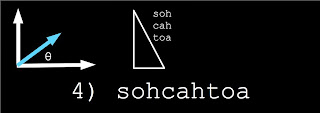Breaking vectors into components will become habitual before the end of your first semester of physics. You will use it in a variety of places. A few monster examples that come to mind are calculating displacement, finding x and y components of velocity during kinematics problems, almost every force problem requires you to break the forces into components, momentum, torque, the list goes on and on. As this will permeate many waking hours of your physics student life, it would be nice to have a procedure to make the operation a little more painless. Go through these five steps each time to make the process a little more mechanical. It will increase your fluency and increase your accuracy, leaving much less room for mistakes.
1) Identify your coordinate axis and draw it on the paper. This is not always defined in the problem. If they don’t require a particular coordinate system in the problem pick what works best for you. HOT TIP: Try to select an axis that lines up with as many vectors as possible in the problem. This will leave less vectors to break into components!
2) Identify your vector and draw it on the paper. I would advise doing a separate drawing for each vector in the problem. This will avoid a lot of confusion because the drawings will get busy and very messy.
3) Identify your angle and draw it on your paper. This is VERY important. The angle matters because your sin/cos/tan change based on which side is opposite and which is adjacent. You can use whatever you’d like but be detailed with your selection!
4)Use sine and cosine relationships for component definition. This step is essentially a nested “do the 6 sohcahtoa steps” step.
5) Box your answer, you’re done!
Okay, wonderful. So we’ve broken the vector into x and y (usually) components. Wonderful, now what? Well, this is the end of the road for now. This recipe can be used in a variety of situations so we can implement it later. The question is, let’s say we’ve broken several vectors into components, all correctly and meticulously like good students. We perform some vector addition and subtraction, and have our final vector components. Now what? How do we reconstruct our final vector? This is usually what the problem will be looking for anyhow. Well, next we have a 5-step recipe for doing just that.
1) Identify the coordinate axis and draw it on the paper. Sound familiar?
2) Identify your components. These should be handy from doing many operations, or else they were probably given in the initial problem.
3) Use the pythagorean theorem to calculate magnitude. a^2 + b^2 = c^2. Solve for c. Remember that we can consider a vector to be a hypotenuse of a right triangle?
4) Use arctangent to calculate angle, i.e. direction. Remember toa? We’re certainly given the opposite and adjacent side if we’re calculating the hypotenuse, so use those sides to calculate angle. Don’t forget to remember if you are in radians or degrees mode!
5) Box your answer, you’re done!
That’s really all there is to it. As before, to gain fluency, it will be useful to run through some examples. The next episodes will go through 4 detailed examples of doing both of these operations.











